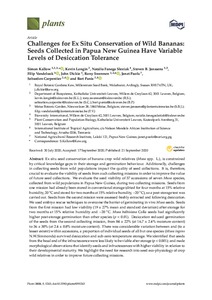| dc.contributor.author | Kallow, S. |
| dc.contributor.author | Longin, K. |
| dc.contributor.author | Sleziak, N.F. |
| dc.contributor.author | Janssens, S.B. |
| dc.contributor.author | Vandelook, F. |
| dc.contributor.author | Dickie, J. |
| dc.contributor.author | Swennen, R. |
| dc.contributor.author | Paofa, J. |
| dc.contributor.author | Carpentier, S.C. |
| dc.contributor.author | Panis, B. |
| dc.date.accessioned | 2021-02-16T11:08:40Z |
| dc.date.available | 2021-02-16T11:08:40Z |
| dc.date.issued | 2020 |
| dc.identifier.citation | Kallow, S., Longin, K., Sleziak, N.F., Janssens, S.B., Vandelook, F., Dickie, J., ... & Panis, B. (2020). Challenges for ex Situ conservation of wild bananas: seeds collected in Papua New Guinea have variable levels of desiccation tolerance. Plants, 9(9), 1243: 1-21. |
| dc.identifier.issn | 2223-7747 |
| dc.identifier.uri | https://hdl.handle.net/20.500.12478/7042 |
| dc.description.abstract | Ex situ seed conservation of banana crop wild relatives (Musa spp. L.), is constrained by critical knowledge gaps in their storage and germination behaviour. Additionally, challenges in collecting seeds from wild populations impact the quality of seed collections. It is, therefore, crucial to evaluate the viability of seeds from such collecting missions in order to improve the value of future seed collections. We evaluate the seed viability of 37 accessions of seven Musa species, collected from wild populations in Papua New Guinea, during two collecting missions. Seeds from one mission had already been stored in conventional storage (dried for four months at 15% relative humidity, 20 °C and stored for two months at 15% relative humdity, −20 °C), so a post-storage test was carried out. Seeds from the second mission were assessed freshly extracted and following desiccation. We used embryo rescue techniques to overcome the barrier of germinating in vivo Musa seeds. Seeds from the first mission had low viability (19 ± 27% mean and standard deviation) after storage for two months at 15% relative humidity and −20 °C. Musa balbisiana Colla seeds had significantly higher post-storage germination than other species (p < 0.01). Desiccation reduced germination of the seeds from the second collecting mission, from 84 ± 22% (at 16.7 ± 2.4% moisture content) to 36 ± 30% (at 2.4 ± 0.8% moisture content). There was considerable variation between and (to a lesser extent) within accessions, a proportion of individual seeds of all but one species (Musa ingens N.W.Simmonds) survived desiccation and sub-zero temperature storage. We identified that seeds from the basal end of the infructescence were less likely to be viable after storage (p < 0.001); and made morphological observations that identify seeds and infructescences with higher viability in relation to their developmental maturity. We highlight the need for research into seed eco-physiology of crop wild relatives in order to improve future collecting missions. |
| dc.description.sponsorship | Bill & Melinda Gates Foundation |
| dc.description.sponsorship | Research Foundation-Flanders |
| dc.description.sponsorship | CROP TRUST |
| dc.description.sponsorship | Global TRUST Foundation |
| dc.format.extent | 1-21 |
| dc.language.iso | en |
| dc.subject | Bananas |
| dc.subject | Ex-situ Conservation |
| dc.subject | Drying |
| dc.subject | Musa |
| dc.subject | Plant Genetic Resources |
| dc.subject | Paupa New Guinea |
| dc.subject | Desiccation |
| dc.subject | Seed Storage |
| dc.title | Challenges for ex Situ conservation of wild bananas: seeds collected in Papua New Guinea have variable levels of desiccation tolerance |
| dc.type | Journal Article |
| cg.contributor.crp | Roots, Tubers and Bananas |
| cg.contributor.affiliation | Royal Botanic Gardens Kew |
| cg.contributor.affiliation | Katholieke Universiteit, Leuven |
| cg.contributor.affiliation | Meise Botanic Garden, Belgique |
| cg.contributor.affiliation | Bioversity International |
| cg.contributor.affiliation | International Institute of Tropical Agriculture |
| cg.contributor.affiliation | National Agricultural Research Institute, Papua New Guinea |
| cg.coverage.region | Africa |
| cg.coverage.region | Africa South of Sahara |
| cg.coverage.country | Papua New Guinea |
| cg.coverage.hub | Eastern Africa Hub |
| cg.researchtheme | Biotech and Plant Breeding |
| cg.identifier.bibtexciteid | KALLOW:2020 |
| cg.isijournal | ISI Journal |
| cg.authorship.types | CGIAR and developing country institute |
| cg.iitasubject | Agronomy |
| cg.iitasubject | Banana |
| cg.iitasubject | Plant Breeding |
| cg.iitasubject | Plant Genetic Resources |
| cg.iitasubject | Plant Production |
| cg.journal | Plants |
| cg.notes | Open Access Journal; Published online: 21 Sept 2020 |
| cg.accessibilitystatus | Open Access |
| cg.reviewstatus | Peer Review |
| cg.usagerightslicense | Creative Commons Attribution 4.0 (CC BY 0.0) |
| cg.targetaudience | Scientists |
| cg.identifier.doi | https://dx.doi.org/10.3390/plants9091243 |
| cg.iitaauthor.identifier | Rony Swennen: 0000-0002-5258-9043 |
| cg.futureupdate.required | No |

